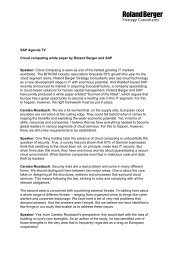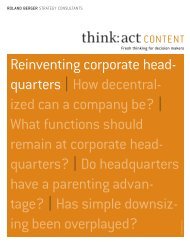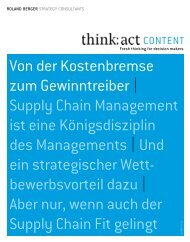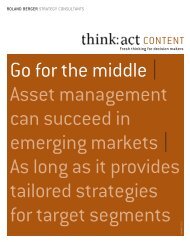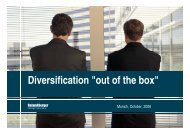Customer-centric retailing â Now you know what ... - Roland Berger
Customer-centric retailing â Now you know what ... - Roland Berger
Customer-centric retailing â Now you know what ... - Roland Berger
Create successful ePaper yourself
Turn your PDF publications into a flip-book with our unique Google optimized e-Paper software.
CUSTOMER-CENTRIC RETAILINGThis business approach can increase thebenefits for the customerActually it doesn't. Because the reality in <strong>retailing</strong> isusually different. The range is still excessively dominatedby the traditional supplier orientation, with retailers concentratingon quantity, turnover and sales. They assumethat cheap is <strong>what</strong> sells, so one campaign follows another.They advertise <strong>what</strong> their buyers can get onto the shelvesat the biggest discount. However, this has little to do withbeing truly customer-oriented.The person who really <strong>know</strong>s <strong>what</strong> the customers wantis the independent shopkeeper, since he spends enoughtime in his shop and with the customers. Large retailgroups can only guess at best: they tend to be quitecentralized and are far away from customers when theytake decisions about ranges, prices and positioning.OF COURSE, EVERYONE SAYS THE CUSTOMER IS KING.BUT IN REALITY THINGS LOOK QUITE DIFFERENT. NOWTHERE IS A TRIED-AND-TESTED METHOD THAT REALLYDOES FOCUS ON THE CUSTOMER: CUSTOMER-CENTRICRETAILING. FOR THE FIRST TIME THERE IS A SYSTEMTHAT ALIGNS THE MARKETING MIX (RANGE, CUSTOMERSERVICE, PRICE AND PROMOTIONS) TO THE CUSTOM-ERS' NEEDS. BUT THERE'S MORE TO IT THAN THAT:IF YOU REALLY WANT TO BE DRIVEN BY WHAT YOURCUSTOMERS WANT, YOU HAVE TO REDEFINE YOURBUSINESS.This store seems to have everything: 80,000 productsacross all food and non-food categories covering well over100,000 square feet of floor space. The range of itemsoffered almost overwhelms <strong>you</strong> when <strong>you</strong> enter this giantshopping temple. If <strong>you</strong> can't find <strong>what</strong> <strong>you</strong> want here, <strong>you</strong>won't find it anywhere. Because this store seems to haveeverything customers want. Or does it?Most major retailers typically have huge amounts of dataat their disposal, regularly engage in market research,often issue loyalty cards, and also have access to precisedaily sales data. Yet they rarely read all this data in anoverall context. If customers are analyzed at all, it is invague sociodemographic terms, and perhaps revenuesand discounted sales figures are compared with thoseof previous years. But these retailers have no idea whobought <strong>what</strong>, when and why."If <strong>you</strong> don't <strong>know</strong> where <strong>you</strong>r customers are going, <strong>you</strong>'llget left behind," says retail expert Professor Nitin Sanghavi(see interview on p. 13) from Manchester BusinessSchool. Classic mom-and-pop stores used to <strong>know</strong> theircustomers personally. So should we go back to the traditionalcorner store? Hardly. So is there any way of combiningthe grocer's closeness to his customers with therange and efficiency of centrally managed retail systems?Doesn't size and centralization always lead to beingremote from the customer?There is a solution to a lack of <strong>know</strong>ledge of <strong>you</strong>r customers:the loyalty card, debit card or credit card. Thedata that is analyzed is not the customers' personal data.Instead, sanitized purchasing data is used to form groupsof customers with similar purchasing patterns (e.g.6




